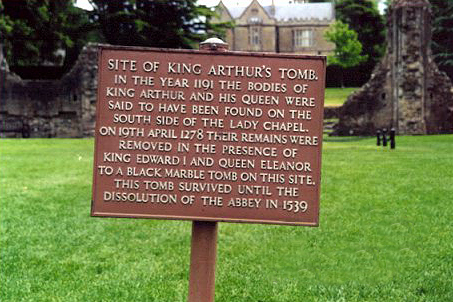

William of Malmesbury, who recorded the history of Glastonbury Abbey just before Geoffrey of Monmouth wrote his own book, specifically denied that the place of Arthur's burial was known. "Arthur's grave, however, is nowhere to be found, whence come the traditional old wives' tales that he may yet return."
And yet, in 1190 (or early 1191), not long after Gerald had completed his journey through Wales, the monks of Glastonbury Abbey claimed to have uncovered a stone slab and a leaden cross inscribed "Here lies the renowned King Arthur in the Isle of Avalon." (This is the earliest identification of Glastonbury with the Avalon of Geoffrey of Monmouth.) Below it, they found a wooden coffin, supposedly containing the bodies of Arthur and Guinevere. Gerald subsequently wrote two accounts of the exhumation, having traced the lettering cut into the cross, himself, and noting the large size of Arthur's bones and how a lock of Guinevere's blond hair had crumbled to dust in a monk's hand.
Henry II, the great patron of the abbey, had died the year before, and in 1190 his successor, Richard I (Coeur de Lion), set off for the Holy Land on the Third Crusade. Six years before, most of the abbey had been destroyed by fire, and the monks were much in need of funds for rebuilding. Their dramatic discovery and the pilgrims that it assured could not have come at a more opportune time.

The discovery of Arthur's body also had political implications for the Welsh, who had revolted in the 1130s, and their Norman overlords. Although it supported the legend, it also deprived that troublesome people of a champion prophesied to return and lead the Welsh in recovering their rightful sovereignty over Britain. As Gerald says, "The fairy-tales have been snuffed out, and the true and indubitable facts are made known..."